fuel consumption AUDI A5 2015 Owner´s Manual
[x] Cancel search | Manufacturer: AUDI, Model Year: 2015, Model line: A5, Model: AUDI A5 2015Pages: 264, PDF Size: 66.83 MB
Page 26 of 264
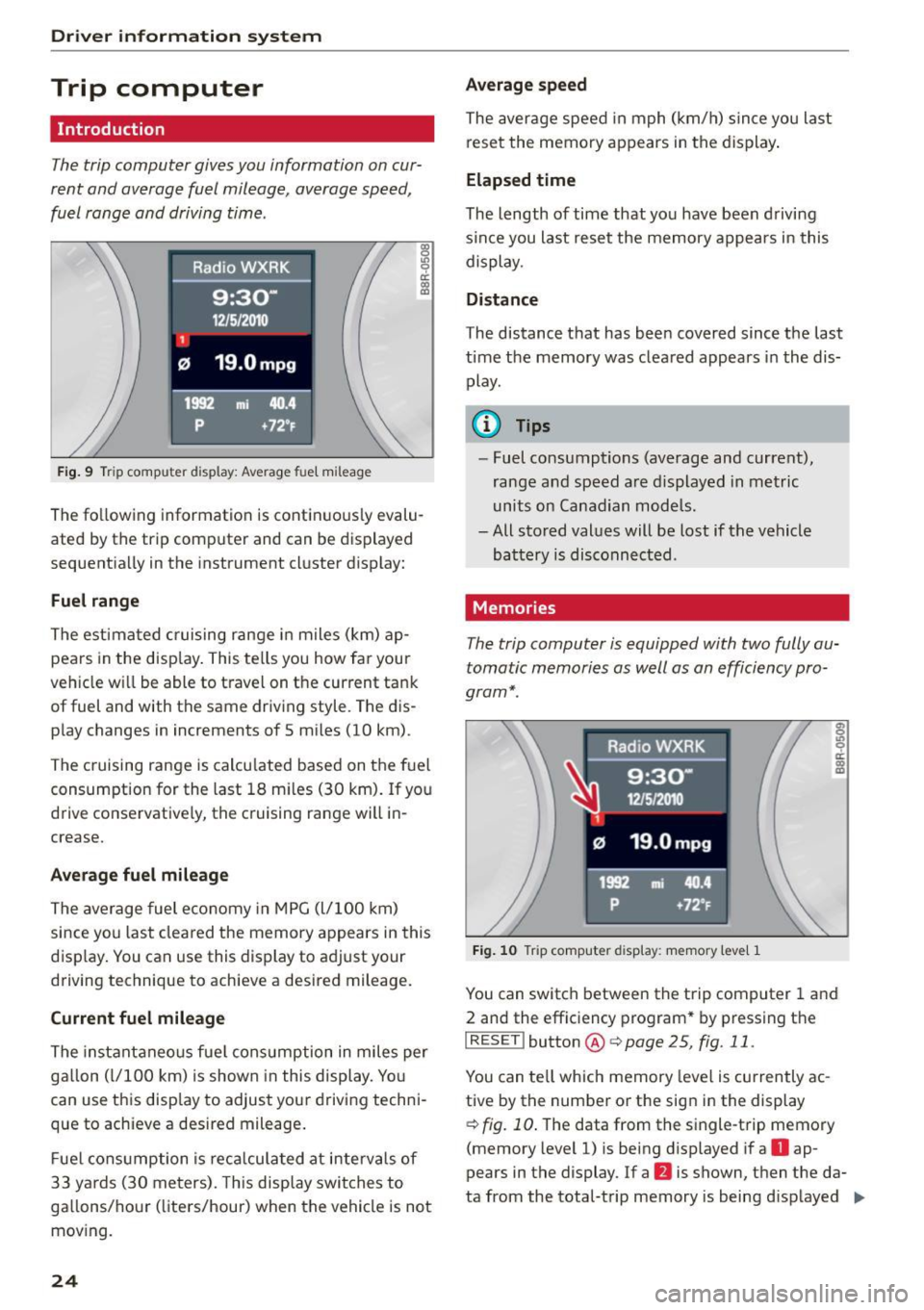
Driver information system
Trip computer
Introduction
The trip computer gives you information on cur
rent and average fuel mileage , average speed ,
fuel range and driving time .
Fig. 9 Trip computer d isplay: Ave rage fuel m ileage
~ 9 a: CX) m
The fo llow ing information is contin uously evalu
ated by the trip computer and can be d isplayed
sequent ia lly in the instrument cluster display:
Fuel range
The estima ted c ruising range i n miles (km) ap
pea rs in the disp lay . This te lls you how fa r your
ve hicle w ill be able to trave l on t he current ta nk
of fuel and with the same driv ing style. The d is
p lay changes in increments of 5 miles (10 km) .
The cruising range is calcu lated based on t he f ue l
consumption for the last 18 m iles (30 km). If yo u
drive conse rvative ly, the cruising range will in
crease.
Average fuel mileage
The average fuel e co nomy in MPG (l/ 100 k m)
since yo u last cleared the memory appears in this
d is pl ay. You can use this display to ad just your
driving technique to achieve a desired mileage.
Current fuel mileage
The inst antaneo us f ue l cons umption in miles per
ga llon (l/100 km) is shown in this display. Yo u
can use t his disp lay to adjust your driving techni
que to achieve a des ired mileage .
F ue l cons umption is rec alcul ated at intervals of
33 y ards (30 me ters). Th is disp lay swit ches to
ga llons/hou r (li ters/hour) when the vehicle is not
mov ing.
24
Average speed
The aver age spee d in mph (km/ h) sin ce you last
rese t the memory appears in the display .
Elapsed time
The length of time that yo u have been d riving
s ince you last reset the memory appears in this
display .
Distance
The distance that has been covered since the last
time the memory was cleared appears i n the dis
play .
0) Tips
-Fuel consumptions (average and current),
range and speed a re displayed in me tric
units on Canad ian mode ls .
- All stored val ues will be lost if the vehicle
bat tery is disconnected .
Memories
The trip computer is equipped with two fully au
tomatic memories as well as an efficiency pro
gram* .
Fig. 10 Tri p comput er di sp la y: me mory leve l 1
You can switch between the trip computer 1 and
2 and the efficiency program* by p ressing t he
I RESET I button @<=> page 25, fig. 11 .
You can tell wh ic h memory leve l is currently ac
tive by the number o r the sig n in the display
Q fig. 10. The data from the single-t rip memory
(memo ry leve l 1) is being d isplayed if a
D ap
pears in the display. If a
fJ is shown, t hen the da-
ta from the total-t rip memory is being d isp layed .,,_
Page 28 of 264
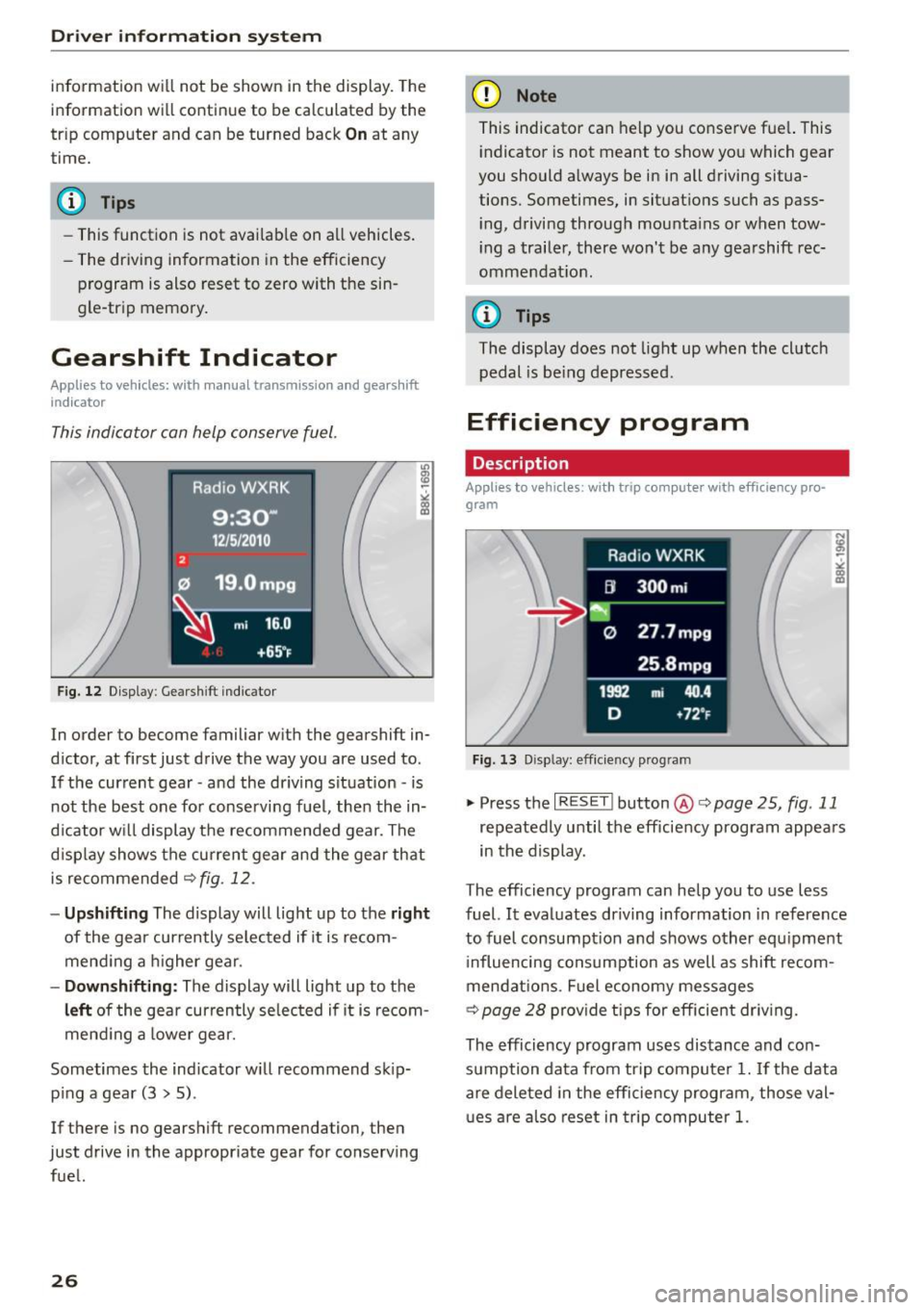
Drive r in formation syste m
information w ill not be shown in the display. The
information will continue to be ca lculated by the
tr ip computer and can be turned back
On at any
time.
(D Tips
- This function is not availab le on a ll vehicles.
- The driving information in the efficiency
program is also reset to zero with the sin
gle-tr ip memory.
Gearshift Indicator
Applies to vehicles: with manual transmission and gearsh ift
indicator
This indicator con help conserve fuel.
Fig. 12 Display: Gearshift indic ator
In order to become familiar with the gearshift in
d ictor, at first just drive the way you are used to .
If the current gear -and the dr iving situation -is
not the best one for conserving fuel , then the in
dicator wi ll display the recommended gear . The
d isp lay shows the cu rrent gear and the gear that
is recommended
¢ fig . 12 .
-Up shifting The display will light up to the r ight
of the gear currently se lected if it is recom
mend ing a h igher gear .
-Dow nshifting : The display will light up to the
left of the gear currently se lected if it is recom
mend ing a lower gear.
Sometimes the indicator w ill recommend sk ip
p ing a gear (3
> 5) .
If there is no gearshift recommendation, then
just drive in the appropriate gear for conserving fuel.
26
(D Note
This indicator can help you conserve fue l. This
i ndicator is not meant to show you which gear
you should always be in in all driving situa
tions. Sometimes, in situations such as pass
i ng, driving through mounta ins or when tow
ing a trailer, there won't be any gearshift rec
ommendation .
(0 Tips
The display does not light up when the clutch
pedal is be ing depressed.
Efficiency program
Description
Applies to vehicles: with trip compute r with efficiency pro·
gram
Fig. 13 Disp lay: eff icie ncy prog ram
"'"Press the I RESET ! button ®¢ page 25, fig . 11
repeatedly until the efficiency program appears
in the display.
T he efficiency program can help you to use less
fuel. It eval uates driving information in reference
to fuel consumpt ion and shows other equ ipment
i nfluencing consumption as well as shift recom
mendat ions . Fuel economy messages
¢ page 28 provide tips for efficient dr iv ing .
The efficiency program uses distance and con sumption data from trip computer
1. If the data
are deleted in the efficiency program, those val
u es are also reset in trip computer
1.
Page 29 of 264
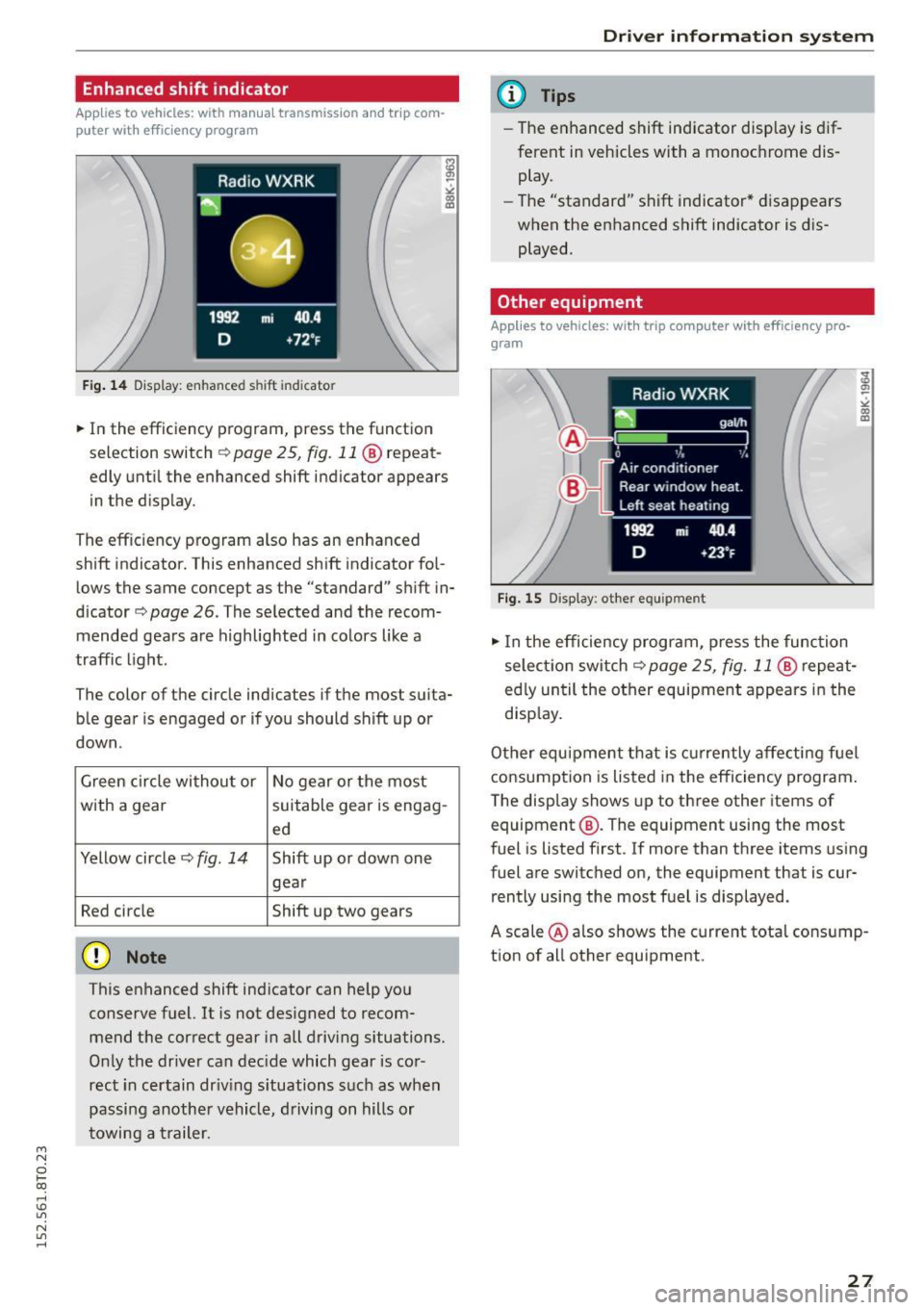
M N
0 loo
rl I.O
"' N
"' rl
Enhanced shift indicator
Applies to vehicles: with manual transmission and trip com
p uter with eff iciency program
Fig . 14 Display: enhanced shift indicator
"'In the efficiency program, press the function
selection switch¢
page 25, fig. 11@ repeat
edly until the enhanced shift indicator appears
in the disp lay.
The eff ic iency program also has an enhanced
shift indicator. This enhanced shift indicator fol
lows the same concept as the "standard" shift in
dicator¢
page 26. The se lected and the recom
mended gears are highlighted in colors like a
traffic light.
The color of the circle indicates if the most suita b le gear is engaged or if you should shift up or
down.
Green circle withou t or No gear or the most
with a gear suitable gear is engag-
ed
Yellow circle¢
fig. 14 Shift up or down one
gear
Red circle Shift up two gears
(D Note
This enhanced shift indicator can help you
conserve fuel. It is not des igned to recom
mend the correct gear in all driving situations.
Only the drive r can decide which gear is cor
rect in certain dr iving situations such as when
passing another vehicle, driving on hills or
towing a trailer.
Dri ver information system
(D Tips
- The enhanced shift indicator display is dif
ferent in vehicles with a monochrome dis
play.
- Th e "standard" shift indicator* disappears
when the enhanced shift indicator is dis
played.
Other equipment
Applies to vehicles: with trip computer with efficiency pro
gram
Fig. 15 Display: othe r equ ipm ent
"'In the efficiency program, press the function
select ion switch ¢
page 25, fig. 11 @ repeat
ed ly until the other equipment appears in the
disp lay.
Other equ ipment that is currently affecting fuel
consumption is listed in the efficiency program .
The display shows up to three other items of
equipment @. The equipment using the most
fuel i s listed first. If more than three items using
fuel are switched on, the equipment that is cur rently using the most fuel is displayed.
A scale @also shows the current total consump
tion of all other equipment.
27
Page 30 of 264
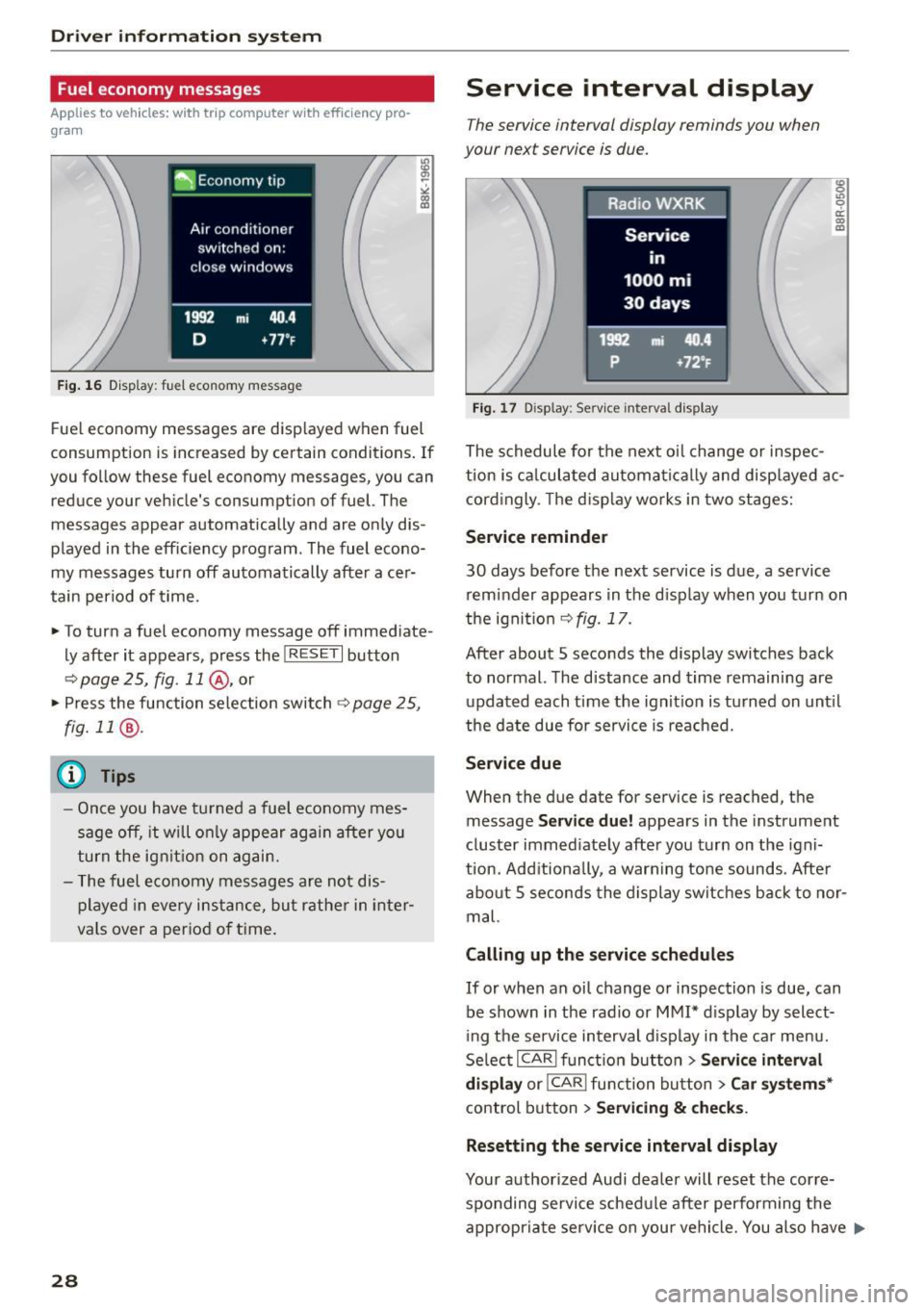
Drive r in formation syste m
Fuel economy messages
App lies to veh icles: w ith tr ip compute r w it h eff ic iency pro
g ra m
F ig . 1 6 Display : fu el economy messag e
Fuel economy messages are disp layed when fuel
consumption is increased by certain conditions.
If
you follow these fuel economy messages, you can reduce your vehicle 's consumption of fuel. The
messages appear automatically and are only dis
played in the eff ic iency program . The fuel econo
my messages turn
off automatically after acer
tain period of time.
• To turn a fuel economy message
off immed iate
ly after it appears, press the !R ESET I button
¢ page 25, fig . 11 @, or
• Press the function selection switch~
page 25 ,
fig. 11
® ·
@ Tips
- Once you have turned a fuel economy mes
sage off, it will on ly appear again after yo u
turn the ign it ion on again.
- The fuel economy messages are not dis
played in every instance, but rather in inter
vals over a per iod of t ime.
28
Service interval display
T he service interval display reminds you when
your next service is due.
Fig. 17 D isp lay : Se rvice i nterval dis play
<0 0
"' 0 a: co m
The schedule for the next oi l change or inspec
tion is ca lculated automatically and disp layed ac
cord ingly . T he d isp lay works in two stages:
Service r eminder
30 days before the next service is due, a service
reminder appears in the d isp lay when you turn on
the ignit ion
q fig. 17 .
After about 5 second s the display switches back
to norma l. The distance and time remaining are
updated each time the ignit ion is turned on unt il
the date due for service is reached.
Ser vice due
When the due date for service is reached, the
message
Se rvice due! appears in the instrume nt
cluster immed iately after you turn on the igni
tion. Additiona lly, a warning tone sounds . After
about 5 seconds the d isplay switches back to nor
mal.
Calling up the service schedul es
If or when an oil change or inspection is due, can
be shown in the radio or MMI* d isplay by select
i ng the service interval d isplay in the ca r menu.
Se lect
I C ARI funct ion but ton > Serv ic e interval
di spla y
or!CAR lfunction button> Ca r sy ste ms*
control b utton > Se rvicing & check s.
Resetting the servic e interval display
Your authorized Audi deale r will reset the corre
sponding service schedule after performing the
appropria te service on your vehicle. You also have ..,.
Page 181 of 264
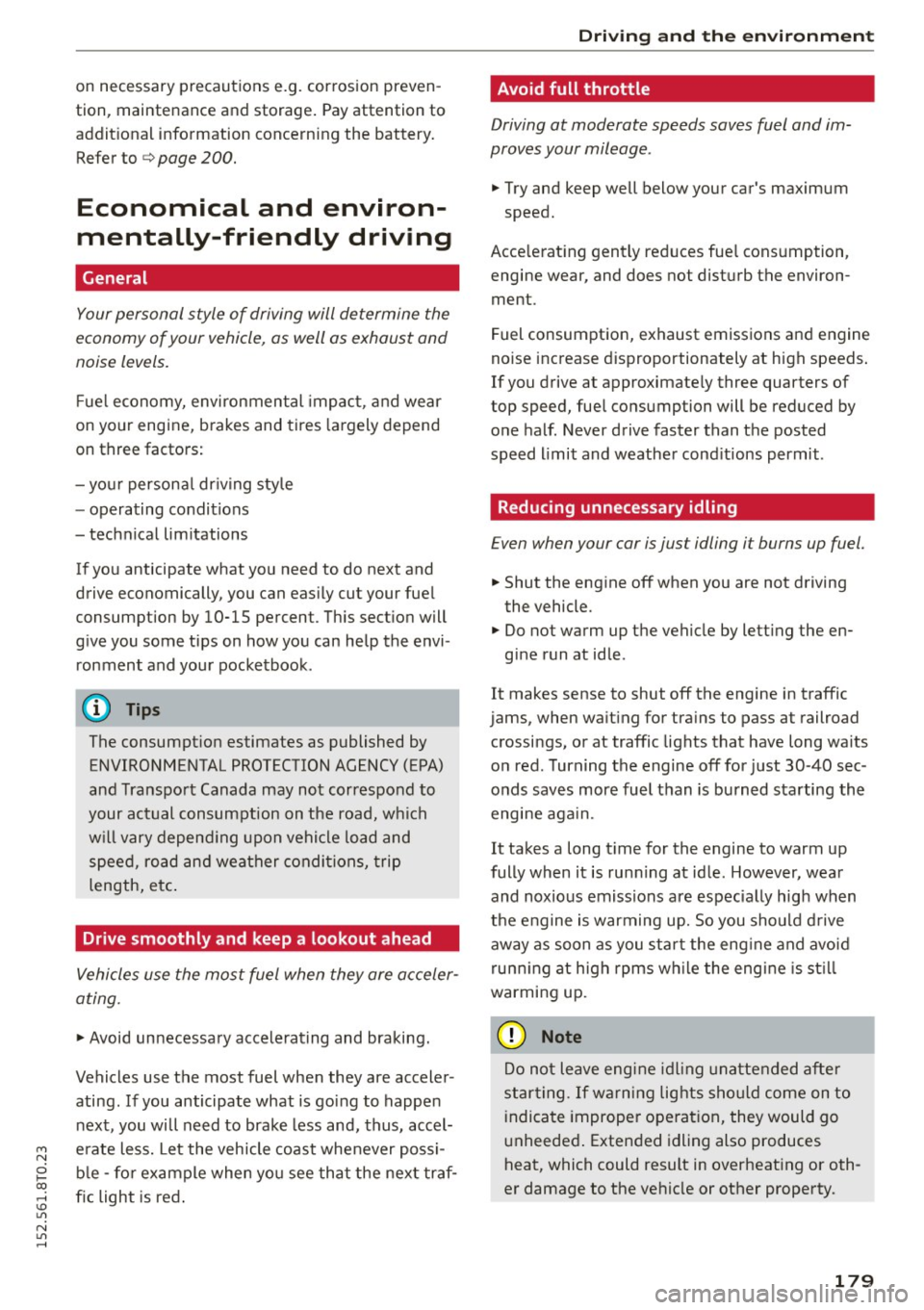
M N
i? co ,...., \!) 1.1'1
N 1.1'1 ,....,
on necessary precautions e.g. corrosion preven
tion, maintenance and storage. Pay attention to
addit ional information concern ing the battery.
Refer to
c> page 200.
Economical and environ
mentally-friendly driving
General
Your personal style of driving will determine the
economy of your vehicle, as well as exhaust and
noise levels.
Fu el economy, environmental impact , and wear
on your engine, brakes and tires largely depend
on three factors:
- your persona l dr iving style
- operating conditions
- technical limitations
If you anticipate what you need to do next and
drive economically, you can easily cut your fuel
consumption by 10-15 percen t. This sec tion will
give you some tips on how you can help the envi
ronment and your pocketbook .
(!) Tips
The consumpt ion estimates as published by
ENVIRONMENTAL PROTECTION AGENCY (EPA)
and Transport Canada may not correspond to
your actual consumption on the road, which
w ill vary depending upon vehicle load and
speed, road and weather conditions, trip
length, etc.
Drive smoothly and keep a lookout ahead
Vehicles use the most fuel when they are acceler
ating.
" Avoid unnecessary accelerating and braking.
Vehicles use the most fuel when they are acceler
ating . If you anticipate what is going to happen
next, you will need to brake less and, thus, accel
e rate less. Let the vehicle coast whenever possi
ble - for example when yo u see that the next traf
fic light is red .
Driving and the environment
Avoid full throttle
Driving at moderate speeds saves fuel and im
proves your mileage .
"Try and keep well below your car's maximum
speed.
Acce lerat ing gently reduces fue l consumption,
engine wear, and does not disturb the environ
ment .
Fuel consumption, exhaust emissions and engine
noise increase disproportionately at high speeds.
If you drive at approximate ly three quarters of
top speed, fuel consump tion will be reduced by
one half. Never drive faster than the posted
speed l imit and weather cond itions permit .
Reducing unnecessary idling
Even when your car is jus t idling it burns up fuel.
" Shut the eng ine off when you are not driving
the vehicle.
" Do not warm up the vehicle by lett ing the en-
gine run at idle.
It makes sense to shut off the engine in traffic
jams, when wa iting for tra ins to pass a t railroad
crossings, or at traffic lights that have long waits
on red . Turning the engine
off for just 30-40 sec
onds saves more fue l than is burned starting the
. . engine again.
It takes a long t ime for the engine to warm up
fully when it is running at idle. However, wear
and noxious emissions are especially high when
the engine is warming up. So you should drive
away as soon as you sta rt the engine and avoid
running at high rpms wh ile the engine is st ill
warming up.
(D Note
Do not leave engine idling unatt ended afte r
starting .
If warning lights should come on to
indicate improper operation, they would go
un heeded . Extended idling also produces
heat, which could result in overheating or oth
er damage to the vehicle or other property.
179
Page 182 of 264
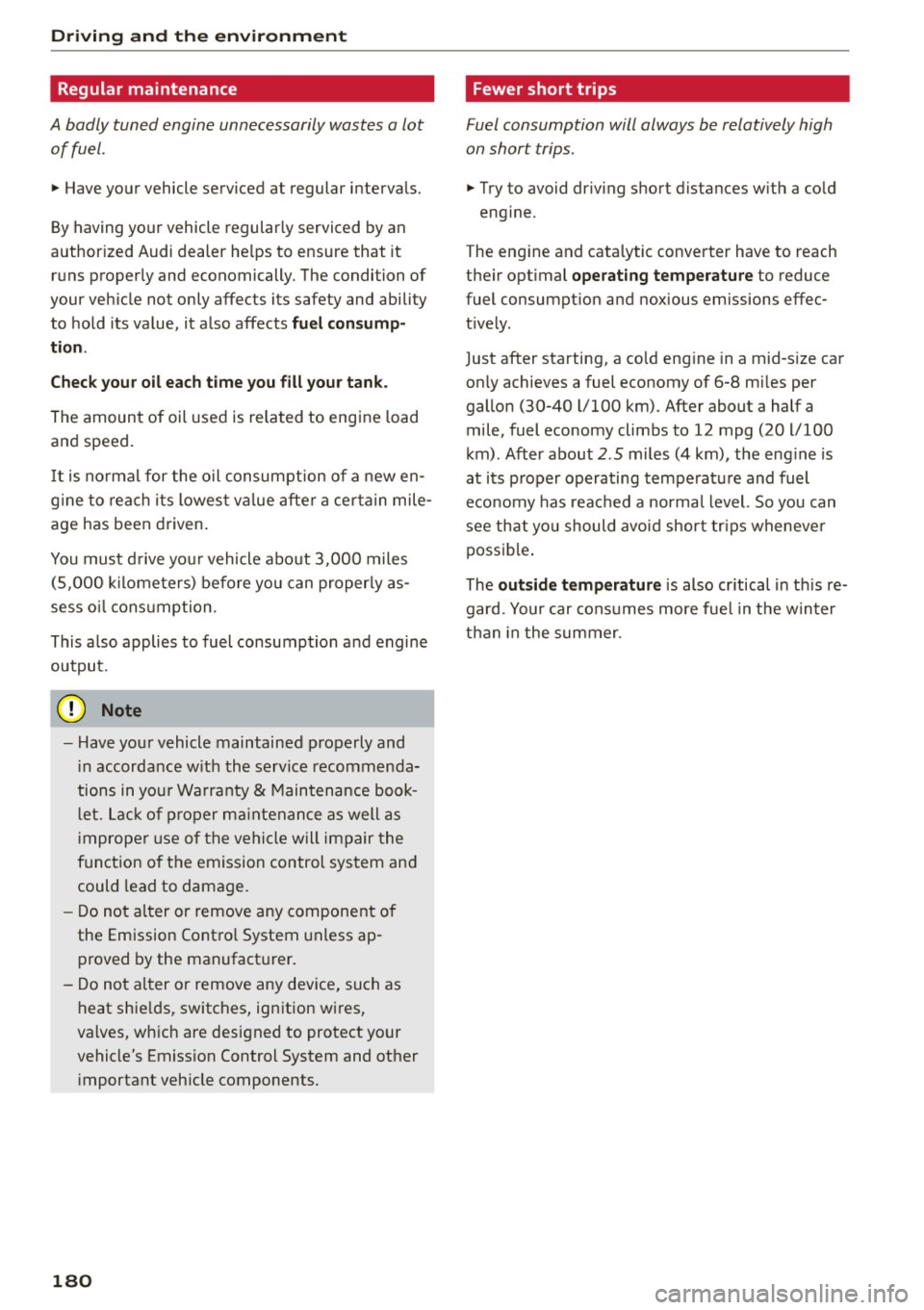
Driving and th e environment
Regular maintenance
A badly tuned engine unnecessarily wastes a lot
of fuel .
.,. Have your vehicle serviced at regula r intervals.
By having your vehicle regularly serviced by an
authorized Audi dealer he lps to ensure that it
runs properly and economically. The condition of
your vehicle not only affects its safety and ability to hold its value, it also affects
f uel c onsump
tion .
C he ck you r oil e ach t ime you fill you r ta nk .
The amount of oil used is related to engine load
and speed.
It is normal for the oil consumption of a new en
g ine to reach its lowes t va lue after a cer tain mile
age has been d riven .
You must d rive you r vehicle about 3,000 miles
(5 ,000 k ilometers) before you can properly as
sess o il cons umption .
This a lso applies to fuel consumption and engine
output.
(D Note
- Have your vehicle maintained properly and
in accordance w ith the service recommenda
tions in you r Warra nty
& M aintenance book
l et . Lack of p roper m aintenance as well as
i mprope r use of the vehicle will impair the
funct ion of the emission control system and
could lead to damage.
- Do not a lter or remove any component of
the Emission Cont ro l System unless ap
proved by the manufacturer.
- Do not a lter o r remove any dev ice, such as
heat shie lds, switches, ignition wires,
va lves, which are designed to protect your
vehicle's Emiss ion Control System and other
i mportant veh icle components.
180
· Fewer short trips
Fuel consumption will always be relatively high
on short trips .
.,. Try to avoid dr iv ing short distances with a cold
eng ine .
The eng ine and catalytic converter have to reach
their opt imal
oper atin g temperature to reduce
fuel consumpt ion and noxious emissions effec
tively .
Just after starting, a co ld engine in a mid-s ize car
on ly achieves a fuel economy of 6-8 mi les per
gallon (30-40 l/100 km). After about a half a
mile, fuel economy climbs to 12 mpg (20 l/100
km) . After about
2.5 miles (4 km), the eng ine is
at its proper operating temperature and fuel
economy has reached a norma l level. So you can
see that you should avo id short trips whenever
poss ible .
The
out side t emp eratur e is also cr itical in th is re
gard. Your car consumes more fuel in the winter
than in the summer.
Page 189 of 264
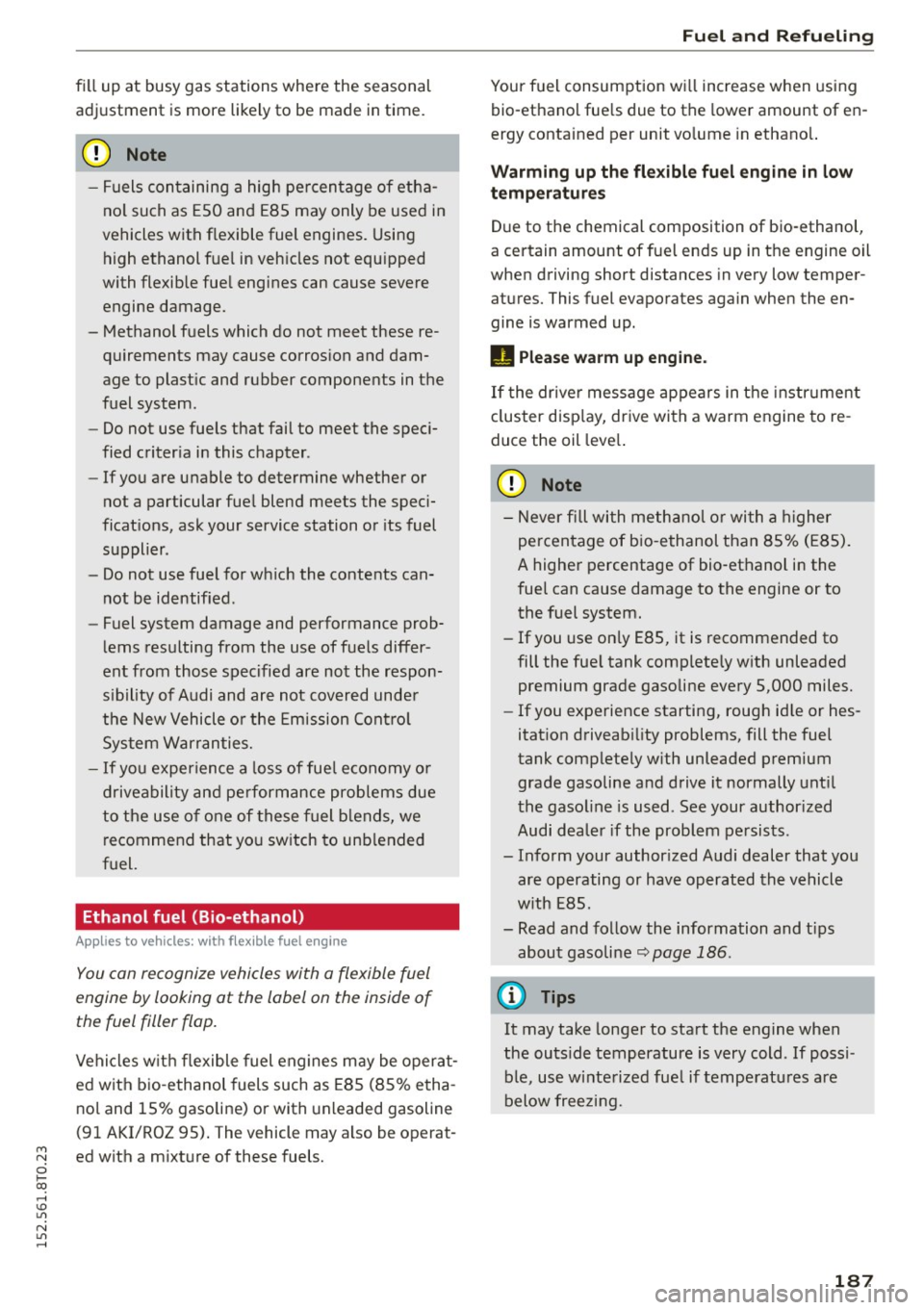
M N
i? co ,...., \!) 1.1'1
N 1.1'1 ,....,
fill up at busy gas stations where the seasonal
adjustment is more likely to be made in time.
(D Note
- Fuels containing a high pe rcentage of etha
no l such as ESQ and E85 may only be used in
vehicles with f lexible fuel engines. Using
high ethanol fuel in veh icles not equ ipped
with flexible fuel engines can cause severe
engine damage.
- Methanol fuels which do not meet these re quirements may cause corrosion and dam
age to plastic and rubber components in the
fuel system.
- Do not use fuels that fail to meet the spec i
fied criter ia in this chapter .
- If you are unable to determine whether or
not a particular fuel blend meets the speci
fications, ask your service station or its fuel
supplier .
- Do not use fuel for wh ich the contents can
not be identified.
- Fuel system damage and performance prob
lems resulting from the use of fuels differ
ent from those spec ified are not the respon
s ibility of Audi and are not covered under
the New Vehicle o r the Emission Cont ro l
System Warranties.
- If you experience a loss of fue l economy o r
driveability and pe rformance problems due
to the use of one of these f uel b lends, we
r ecommend that yo u switch to unb lended
fuel.
Ethanol fuel (Bio-ethanol)
Applies to vehicles: with flexible fuel engine
You can recognize vehicles with a flexible fuel
engine by looking at the label on the inside of the fuel filler flap.
Vehicles w ith f lexible fuel engines may be operat
ed with bio-ethanol fuels such as E85 (85% e tha
nol and 15% gasoline) or with unleaded gasoline
(91 AKI/ROZ 95) . The vehicle may also be operat
ed with a m ixt ure of these fuels.
Fu el and R efu elin g
Your f uel consumption wi ll increase when using
bio-ethano l fue ls due to the lower amount of en
ergy contained per unit vo lume in ethano l.
Warming up the fle xible fuel engine in low
t e mperatu res
Due to the chemical composition of b io-ethanol,
a certain amount of fue l ends up in the engine oil
when driving short distances in
very low temper
atures. This fuel evaporates again when the en
gine is warmed up .
II Please w arm up eng ine .
If the driver message appears in the instrument
cluster disp lay, drive with a warm engine to re
duce the oil leve l.
(D Note
-Never fill with methano l or with a h igher
percentage of b io-ethanol than 85% (E85).
A highe r percentage of bio-ethanol in the
fue l can cause damage to the engine or to
the fuel system.
- If you use on ly E85, it is recommended to
fill the fue l tank complete ly w ith unleaded
premium grade gasoline every 5,000 miles.
- If you experience starting, rough id le or hes
itat ion driveab ility problems, fill the fuel
tank complete ly w ith unleaded premium
grade gasoline and drive it normally unt il
the gaso line is used. See your author ized
Audi dea ler if the problem pe rsists.
- Inform your author ized Audi dealer that you
are operating or have operated the vehicle
w ith E85.
- Read and follow the information and t ips
about gasoli ne
c::> page 186 .
(D Tips
It may take longer to start the engine when
the outs ide temperature is
very cold. If possi
ble, use winte rized fue l if tempe ratu res are
below free zin g.
187
Page 196 of 264
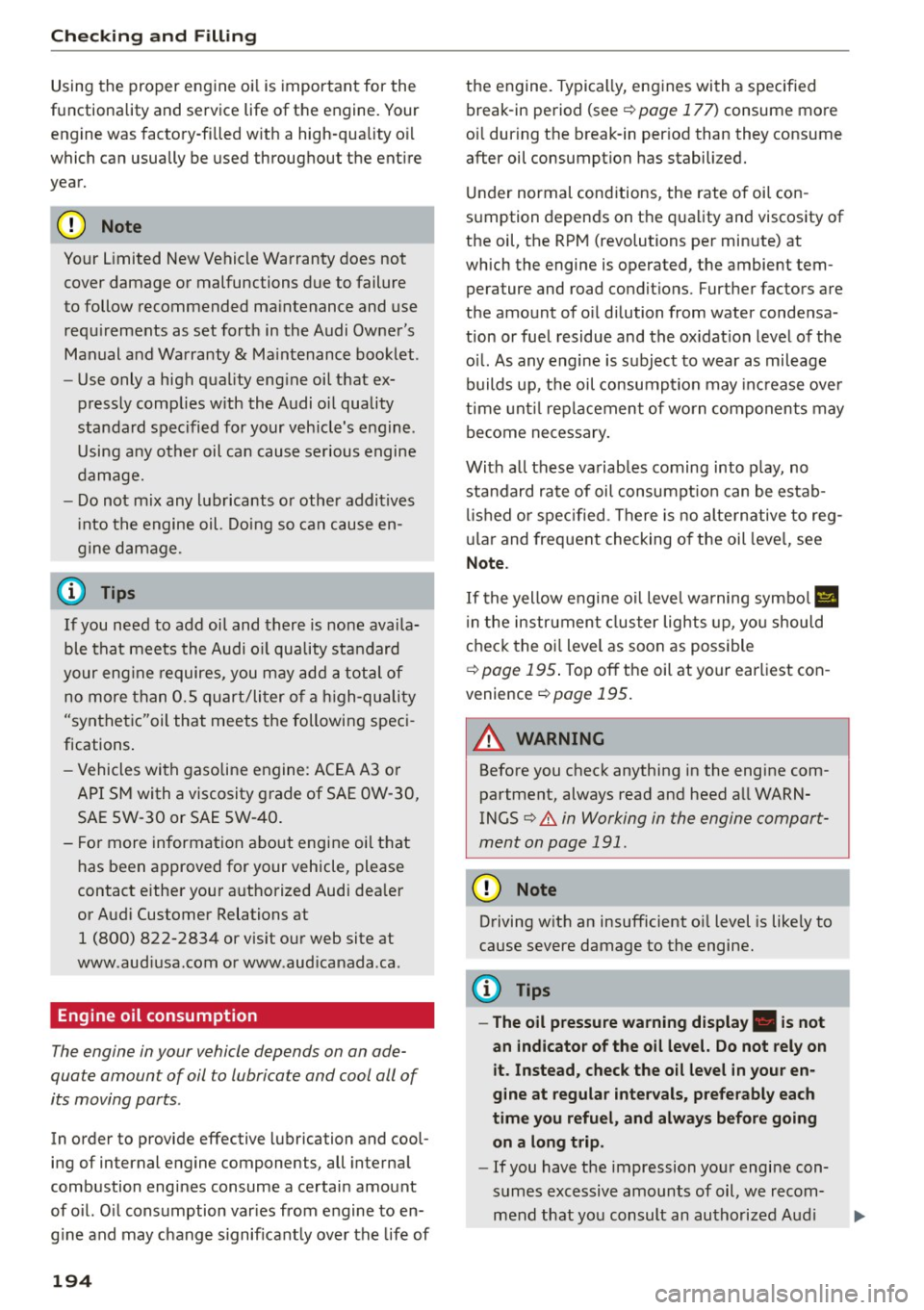
Checking and F ill in g
Using the proper engine o il is important for the
functionality and service life of the engine. Your
engine was factory-fi lled w ith a high-quality o il
which can usually be used throughout the ent ire
year.
@) Note
Your L imited New Vehicle Warranty does not
cover damage or malfunctions due to failure
to follow recommended ma intenance and use
requ irements as set forth in the Audi Ow ne r's
Manual and Wa rranty
& Ma intenance booklet .
- Use only a high quality eng ine oil t hat ex-
pressly comp lies w ith the Audi o il quality
standard specified for your vehicle's e ngine .
Using a ny other oil can cause se rious engine
damage.
- Do not mix any lubricants o r othe r addit ives
i nto the engine oil. Doing so can cause en
g ine damage.
(D Tips
If you need to add oil and there is none availa
ble that meets the Audi o il quality standard
y o ur eng ine requires, you m ay add a total of
no more than 0.5 quart/li ter o f a h igh-quali ty
"synthet ic"oil that meets the fo llowing speci
fications .
- V ehicles wi th gasoline engine: AC EA A3 o r
API SM with a viscosity grade of SAE 0W- 30,
SAE SW -30 or SAE SW-40 .
- Fo r more informa tion abo ut engine oi l that
has been approved for your vehicle, please
contact either you r a uthorized Aud i dea ler
or Audi Customer Relations at
1 (800) 822-2834 or visit o ur web site at
www .aud iusa.com or www .aud icanada .ca .
Engine oil consumption
The engine in your vehicle depends on an ade
quate amount of oil to lubricate and cool all of
its moving parts .
In order to provide effective lubrication and cool
i n g of internal engine components, all interna l
combustion engines consume a certai n amount
of oil. O il consumption var ies from engine to en
g ine and may change significant ly ove r the life of
194
the engine. Typically, eng ines with a specif ied
break-in period (see
¢ page 177) consume mo re
o il dur ing the b reak -in per iod than they consume
after oil consumption has stabili zed.
U nder normal cond itions , the rate of oi l con
s u mption depends on t he qu ality and viscosity of
the oil, the RPM (revolutions per minute) at
which the engine is operated, the ambient tem
perature and road condit ions. Further factors are
the amount of o il di lution from water condensa
tion or fuel residue and the ox idat ion level of the
o il. As any engine is s ubject to wear as mileage
builds up, t he oil consump tion may inc rease ove r
t ime unt il rep lacement of wo rn component s may
become necessary.
With a ll these va riab les coming into p lay, no
sta ndard ra te of oil consumpt ion can be estab
li shed or spe cified . There i s no altern ative to reg
u la r and freq uent checking o f the oil leve l, see
Note .
If the yellow e ngine oi l leve l wa rning symbo l El
in the instr ument cluster lights up, yo u should
chec k the o il level as soon as possible
¢ page 195 . Top off the oil at your ear liest con
venience ¢page 195.
A WARNING
Before you chec k anything in the eng ine com
partment, always read and heed a ll WARN
INGS¢ .&. in Working in the engine compart
ment on page 191.
@ Note
Driving with an insufficient oi l level is likely to
cause severe damage to the engine.
(D Tips
- The oil pressu re warning display. is not
an indicator of the oil level. Do not rely on
it . Instead, check the oil level in your en
gine at regular intervals, preferably each
time you refuel, and always before going on a long trip.
- If you have the impression yo ur engine con
sumes excessive amounts of oil, we r ecom-
mend that yo u consult an au tho rized Audi .,.
Page 218 of 264
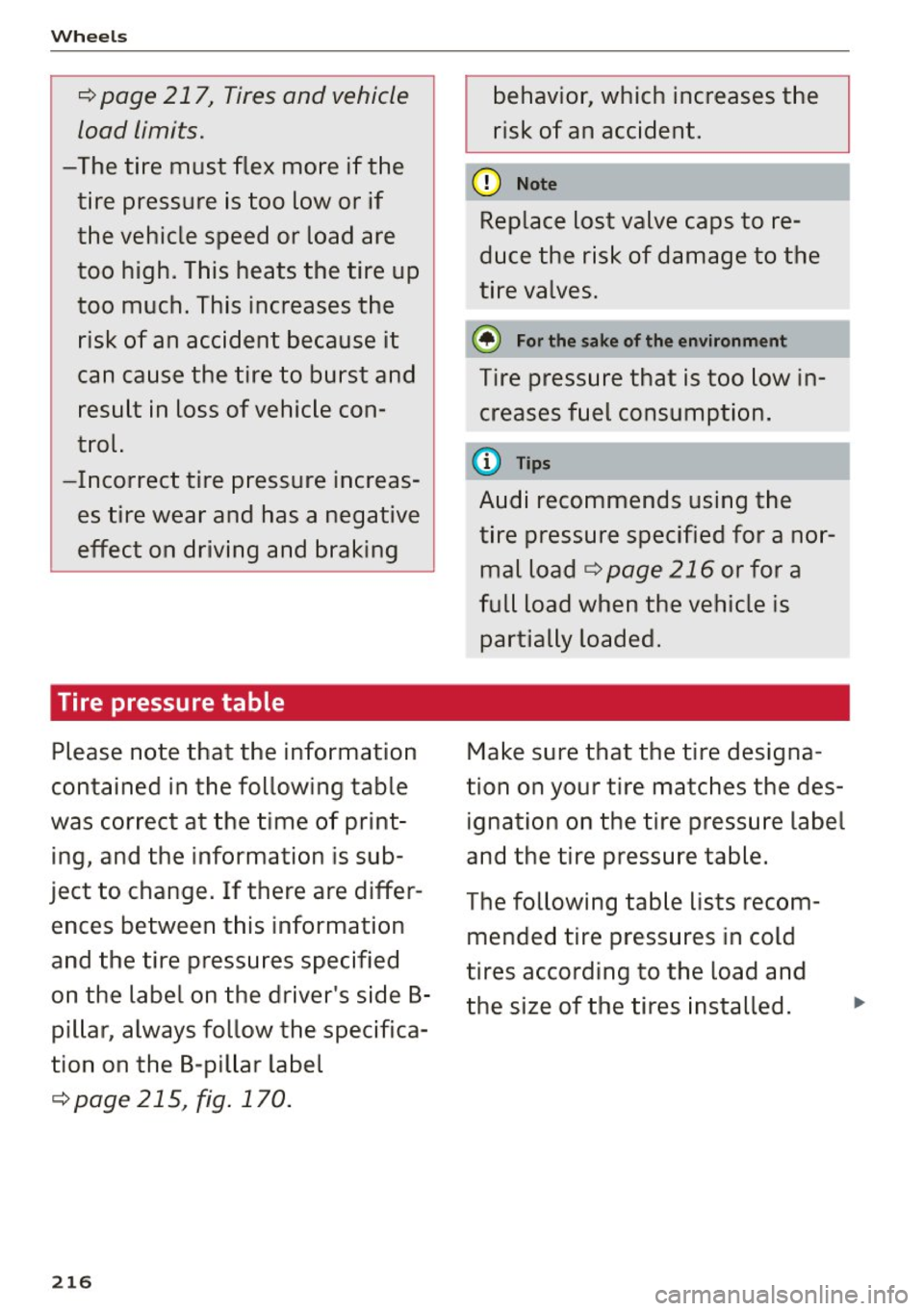
Wheels
c:::> page 217, Tires and vehicle
load limits.
-The tire must flex more if the tire pressure is too low or if
the vehicle speed or load are
too high. This heats the tire up
too much. This increases the
risk of an accident because it
can cause the tire to burst and
result in loss of vehicle con
trol.
-Incorrect tire pressure increas
es tire wear and has a negative
effect on driving and braking
Tire pressure table
Please note that the information
contained in the following table
was correct at the time of print
ing, and the information is sub
ject to change. If there are differ ences between this information
and the tire pressures specified
on the label on the driver's side 8-pillar, always follow the specifica
tion on the 8-pillar label
c:::> page 215, fig. 170.
216
behavior, which increases the
risk of an accident.
(D Note
Replace lost valve caps to re
duce the risk of damage to the
tire valves.
@ For the sake of the environment
Tire pressure that is too low in
creases fuel consumption.
(D Tips
Audi recommends using the
tire pressure specified for a nor
mal load
c:::> page 216 or for a
full load when the vehicle is
partially loaded.
Make sure that the tire designa
tion on your tire matches the des ignation on the tire pressure label
and the tire pressure table.
The following table lists recom
mended tire pressures in cold
tires according to the load and the size of the tires installed. .,.
Page 254 of 264
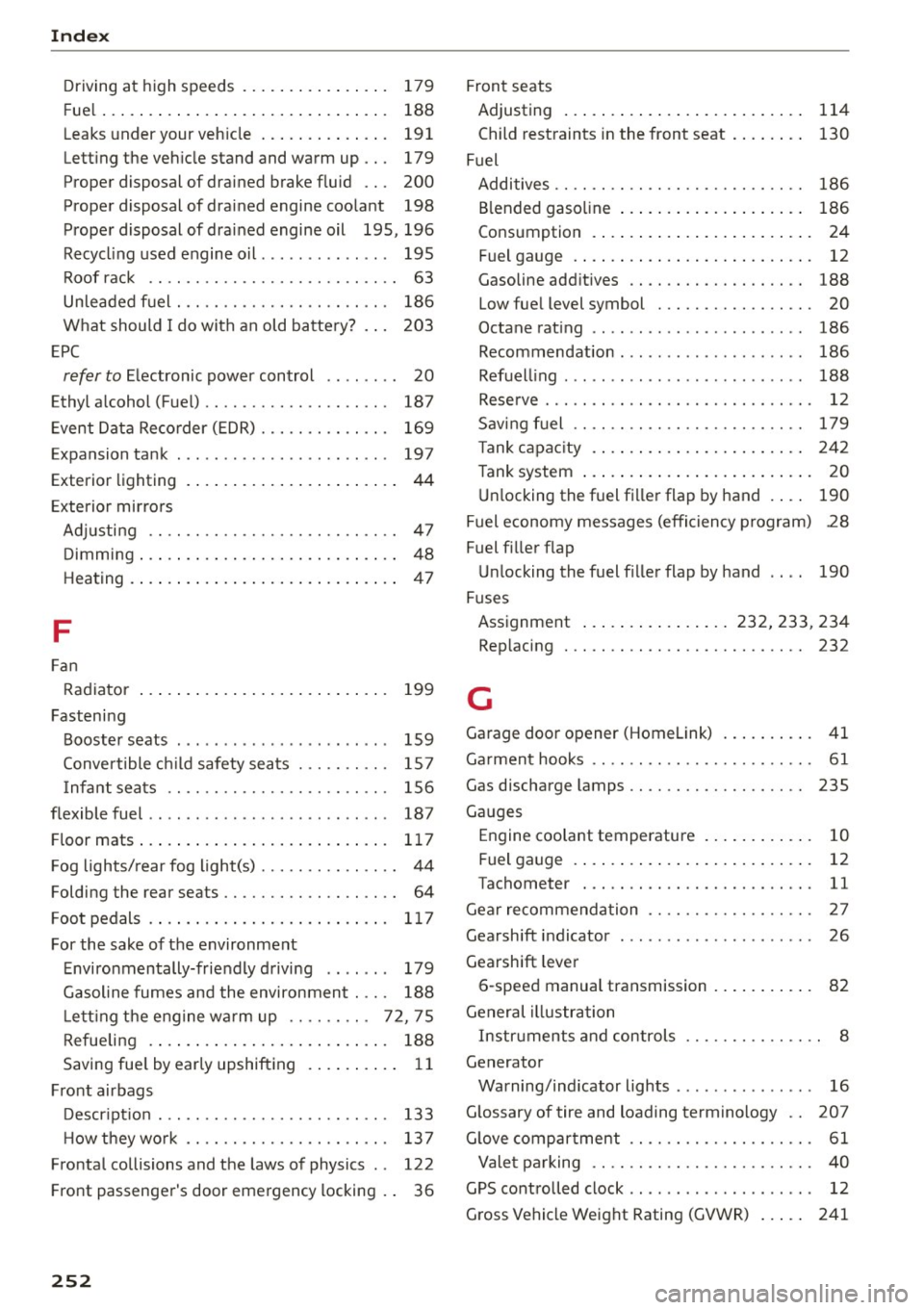
Index
Driving at high speeds . . . . . . . . . . . . . . . . 179
Fuel . . . . . . . . . . . . . . . . . . . . . . . . . . . . . . . 188
Leaks under your veh icle ....... .. .. ... 191
Letting the vehicle stand and warm up... 179
Proper disposal of drained brake fluid . . . 200
Proper disposal of drained engine coolant 198
Proper disposal of drained engine oil 195, 196
Recycling used engine oil . . . . . . . . . . . . . . 195
Roof rack . . . . . . . . . . . . . . . . . . . . . . . . . . . 63
Unleaded fuel . . . . . . . . . . . . . . . . . . . . . . . 186
What should I do with an old battery? . . . 203
EPC
refer to Electronic power control . . . . . . . . 20
Ethyl alcohol (Fuel) . . . . . . . . . . . . . . . . . . . . 187
Event Data Recorder (EDR) . . . . . . . . . . . . . . 169
E xpansion tank . . . . . . . . . . . . . . . . . . . . . . . 197
Exterior lighting . . . . . . . . . . . . . . . . . . . . . . . 44
Exterior mirrors
Adjusting . . . . . . . . . . . . . . . . . . . . . . . . . . . 47
D immi ng ... .. .. ................ ..... 48
Heating. ... .... ................ ..... 47
F
Fan
Radiator
Fastening 199
Booster seats . . . . . . . . . . . . . . . . . . . . . . . 159
Convertible ch ild safety seats . . . . . . . . . . 157
I nfant seats . . . . . . . . . . . . . . . . . . . . . . . . 156
flexible fuel . . . . . . . . . . . . . . . . . . . . . . . . . . 187
Floor mats . . . . . . . . . . . . . . . . . . . . . . . . . . . 117
Fog lights/rear fog light(s) . . . . . . . . . . . . . . . 44
Folding the rear seats . . . . . . . . . . . . . . . . . . . 64
Foot pedals . . . . . . . . . . . . . . . . . . . . . . . . . . 117
For the sake of the environment Environmentally-friendly driving . . . . . . . 179
Gasoline fumes and the environment . . . . 188
L ett ing the engine warm up . . . . . . . . . 72, 75
Refueling . . . . . . . . . . . . . . . . . . . . . . . . . . 188
Saving fuel by early upshifting . . . . . . . . . . 11
Fro nt airbags
Description . . . . . . . . . . . . . . . . . . . . . . . . . 133
H ow they work . . . . . . . . . . . . . . . . . . . . . . 137
Fronta l collisions and the laws of physics . . 122
Front passenger's door emergency locking . . 36
252
Front seats
Adjusting . . . . . . . . . . . . . . . . . . . . . . . . . . 114
Child restraints in the front seat . . . . . . . . 130
Fuel Additives . . . . . . . . . . . . . . . . . . . . . . . . . . . 186
B lended gasoline . . . . . . . . . . . . . . . . . . . . 186
Consumption . . . . . . . . . . . . . . . . . . . . . . . . 24
F u el gauge . . . . . . . . . . . . . . . . . . . . . . . . . . 12
Gasoline additive s . . . . . . . . . . . . . . . . . . . 188
Low fuel level symbol . . . . . . . . . . . . . . . . . 20
Octane rat ing . . . . . . . . . . . . . . . . . . . . . . . 186
Recommendation . . . . . . . . . . . . . . . . . . . . 186
Refuelling . . . . . . . . . . . . . . . . . . . . . . . . . . 188
Reserve . . . . . . . . . . . . . . . . . . . . . . . . . . . . . 12
Saving fuel . . . . . . . . . . . . . . . . . . . . . . . . . 179
Tank capac ity . . . . . . . . . . . . . . . . . . . . . . . 242
Tank system . . . . . . . . . . . . . . . . . . . . . . . . . 20
Unlock ingthefuelfi llerflapbyhand .. .. 190
Fuel economy messages (efficiency program) 28
Fuel filler flap
Unlocking the fuel filler flap by hand . . . . 190
Fuses Assignment ..... .. .. ....... 232, 233, 234
Rep lacing . . . . . . . . . . . . . . . . . . . . . . . . . . 232
G
Garage door opener (Homelink) . . . . . . . . . . 41
Garment hooks . . . . . . . . . . . . . . . . . . . . . . . . 61
Gas discharge lamps . . . . . . . . . . . . . . . . . . . 235
Gauges Engine coolant temperature . . . . . . . . . . . . 10
Fuel gauge . . . . . . . . . . . . . . . . . . . . . . . . . . 12
Tachometer . . . . . . . . . . . . . . . . . . . . . . . . . 11
Gear recommendation . . . . . . . . . . . . . . . . . . 27
Gearshift indicator . . . . . . . . . . . . . . . . . . . . . 26
Gearshift leve r
6-speed manual transmission . . . . . . . . . . . 82
General illustration
Instruments and controls . . . . . . . . . . . . . . . 8
Generator Warning/indicator lights . . . . . . . . . . . . . . . 16
Glossary of tire and loading terminology . . 207
G love compartment . . . . . . . . . . . . . . . . . . . . 61
Valet parking . . . . . . . . . . . . . . . . . . . . . . . . 40
GPS controlled clock . . . . . . . . . . . . . . . . . . . . 12
Gross Vehicle Weight Rating (GVWR) . . . . . 241